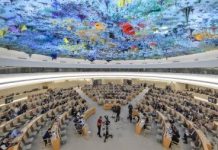Dr. Mehmood Ul Hassan Khan
Indonesia’s macro-economy has been geared up with the constant upward development of its domestic factors and healthy contribution of channel of production since its inception. It has been blended its natural resources, tourism potential, widespread of SMEs, service sector and last but not least nationalistic private sector to achieve numerous socio-economic miracles.
It has been succeeding to achieve its desired goals of constant socio-economic prosperity, qualitative life, eradication of poverty, social networking and political stability because of supremacy of doctrine of a balanced and holistic approach between “growth” and “stability”.
Structural reforms have been playing a positive and productive role in the macro-economy of Indonesia which is a market economy in which the state-owned enterprises (SOEs) and large private business groups play a significant role. They account for about 60 percent of Indonesia’s gross domestic product (GDP) and create employment to nearly 108 million Indonesians.
Major industrial sectors of its economy include petroleum and natural gas, textiles and apparel, mining, footwear, plywood, rubber and chemical fertilisers. The services sector is equally as important to Indonesia’s economy, accounting for 43 per cent of GDP in 2015. Agriculture on the other hand only accounted for 14 per cent.
Indonesia has a market-based liberalized economy in which its government plays a significant role, including administering prices for some basic goods such as fuel, rice and electricity. In terms of value added, the industrial sector accounted for more than 45 per cent of GDP.
It is largest economy in Southeast Asia, which is a diverse archipelago nation of more than 300 ethnic groups. It has charted impressive economic growth since overcoming the Asian financial crisis of the late 1990s.
Statistical data upholds that now Indonesia is the world’s fourth most populous nation, the world’s 10th largest economy in terms of purchasing power parity, and a member of the G-20. It has made enormous gains in poverty reduction, decreasing the poverty rate by more than half since 1999, to 9.78 percent in 2020. Prior to the COVID-19 crisis, Indonesia was able to maintain consistent economic growth, recently qualifying the country to reach upper middle income status.
Indonesia has its own unique economic model which heavily relies on domestic production, savings, investments, proper mobilization and channelization of local resources, nurturing of human capital core and last but not least, positive domestic consumption.
It follows a 20 year development plan, spanning from 2005 to 2025. It has been following people’s friendly social development policies, business and investment friendly programs and plans since long which is now paying its huge socio-economic dividends.
It is segmented into 5 year medium-term plans, called the RPJMN (Rencana Pembangunan Jangka Menengah Nasional) each with different development priorities. The current medium-term development plan the last phase of the long-term plan starts from 2020 to 2024. It aims to further strengthen Indonesia’s economy by improving the country’s human capital and competitiveness in the global market.
Now its macro-economy is feeling the heat of unending COVID-19 due to which social development is compromised but its economic resilience is trying to streamline it.
According to its national data its government implemented emergency fiscal packages equivalent to 3.8 percent of GDP in 2020 and to 4.2 percent of GDP in 2021, to deal with the health impact, provide relief to households and firms, and support the vaccine roll-out, and the recovery.
The World Bank is supporting the Indonesia’s COVID-19 emergency response, including enhancing social assistance and health care systems, while also strengthening the resilience of the financial sector.
Despite COVID-19 it still holds great economic potential. The central government supported to curb Indonesia’s traditional reliance on raw commodity exports, while raising the role of the manufacturing industry within the national economy. Infrastructure development is also a key goal of the government, and one that should cause a multiplier effect within the economy with lots of multiplier effects.
In the past so many years, it was often rated as an appropriate candidate to be included in the BRIC countries (Brazil, Russia, India and China). Furthermore, CIVETS (Colombia, Indonesia, Vietnam, Egypt, Turkey and South Africa) also gained attention as its members have reasonably sophisticated financial systems and fast-growing populations which showed high levels of economic diversification, productivity, and sustainability of Indonesia.
Standard & Poor’s, Fitch Ratings and Moody have upgraded its credit ratings. Resilient economic growth, low government debt and prudent fiscal management have been termed as reasons for the upgrades and are key in attracting financial inflows into Indonesia in terms of FDIs and FPIs.
These FDI inflows, which had been relatively weak for Indonesia during the decade after the Asian Financial Crisis had seriously shaken up the foundations of the country, showed a steep increase after the global financial crisis of 2008-2009.
With promulgation of New Mining Law 2009 Indonesia reduced its traditional reliance on raw commodity exports and boosted the manufacturing industry. With the passage of time, the country is passing through from transition to transformation.
The Indonesian government under the visionary leadership of Joko Widodo has initiated numerous structural reforms aiming at long-term growth. The government rates high priority on infrastructure development and on investment and fiscal incentives that are offered to private investors. Moreover future of its macro-economy is healthy, productive and positive because of having abundant and diverse natural resources with young, large and burgeoning population, immense political stability, institutionalization of prudent fiscal management since the late 1990s, strategic location in relation to the giant economies of China and India, low labour costs and an emerging market.
Indonesia’s micro, small and medium sized enterprises account for 99 percent of the total amount of enterprises which are active in Indonesia. They account for about 60 percent of Indonesia’s GDP and create employment to nearly 108 million Indonesians. These micro, small and medium sized companies are the backbone of the Indonesian economy.
Critical analysis of its macro-economy upholds that Indonesia’s economic growth is starting to accelerate again after the economic slowdown. Now it has again started its journey from the ‘Asian Miracle’ to an emerging economy of the world.
Right from the beginning, Indonesian government has consistently prioritised stability over growth and followed a holistic approach to achieve its economic goals. President Joko Widodo’s program of infrastructure development and economic reform has made progress. However, infrastructure investment needs to be substantially higher, public saving increased through a more comprehensive tax strategy, and business climate reforms recalibrated towards liberalising markets rather than just cutting red tape.
Due to constant structural economic reforms, Indonesia is widely rated as a future economic giant. Now it is the world’s 7th largest economy by purchasing power parity. It hopes that it may be the 5th largest economy in the world by 2030 and fourth soon after. On a market exchange rate basis, Indonesia ranks 16th in the world but will likely enter the top ten by 2030.
Being prominent regional expert I would like to suggest that Indonesian government try to change its national health system. More stringent, cross-sector regulations with detailed protocols for the safe operation of different types of businesses, with specific implications for the various stakeholders should be introduced at once.
Lockdowns have channeled many people online for shopping, learning, entertainment, and working, accelerating the shift to digital services should be the new normal. Simultaneously, companies are pushing ahead with internal digitization for staff, customers, and suppliers (for instance, enhancing supply-chain visibility, offering digital learning experiences, and providing new channels to customers which ought to be implemented.
Undoubtedly, culture of working from home, reducing long-distance travel, and other lockdown habits could lead to a permanent shift toward behaviors that are better for the environment. Companies and governments will seek to address supply-chain flaws revealed by the crisis encouraging domestic sources for strategic goods, such as food and medicine; and generally accelerating the digitization of supply chains.
On part of tourism sector, Indonesia could start marketing its lesser-known tourist attractions to a domestic audience to travel. It could also improve its tourism infrastructure, such as airports, and standards within the hospitality industry.
A mix of modern technology, automation may generate more jobs in Indonesia than are lost between 2014 and 2030. Resultantly, 9-24 million new jobs may be generated. It can build from the online-learning efforts and habits developed during the pandemic to teach those new capabilities more broadly and more quickly. So, journey towards smarter economy and key to further socio-economic prosperity rests on rigorous modernization of macro-economy.
Qualitative infrastructure development is still a concern. There is an urgent need for better logistics to support home deliveries and improved digital infrastructure in general. Improved sanitation and access to clean water, as well as other improvements in conditions, such as a reduction in overcrowded living spaces and multiple access points to homes are the need of the hour.
As we know that Indonesia’s domestic economic structure is different than most countries as about 90 percent of its GDP is comprised of a combination of household consumption (58 percent) and investments (32 percent).
As a result, the impact of COVID-19 on household spending has grave repercussions for the country’s GDP. Household consumption is expected to drop 4.4 percent, or IDR 395 trillion, in 2020 which should be resolved through strengthening policy to boost household consumption by accelerating the social protection program to help the targeted community receive the support in time, for example with voucher disbursement and cash handouts. Moreover, suppress unemployment by being more proactive in supporting businesses in priority sectors to help more Indonesians keep their jobs may be a noble idea in this regard.
In terms of financial reforms, further strengthening of capital market policy to expedite the index recovery to its pre-crisis level should be initiated. Indonesia can use knowledge from potential development and resolving it before creating a chain of bankruptcies. One approach is through a top-down injection of credit, such as providing working capital support to larger distributors.other countries, such as Malaysia, which has almost recovered its capital market.
All efforts should be coordinated to prevent a massive credit crunch by quickly identifying it. Revitalizing manufacturing, acceleration of making Indonesia 4.0 initiatives to reposition its manufacturing strength from a low-cost labor location for commodity products to a high-productivity location for more value-added products should be implemented as soon possible. Indonesia should also focus on developing its digital economy. Its digital service ecosystem is still at initial stage with a focus on the domestic market.
Boosting of ICT spending to stimulate growth may be quick remedy in this regard. Increase of the quantity and quality of digital talents to enable the supply of innovative digital services may be a workable solution. Revolutionize logistics and supply chain with digital technologies should be the future of its macro-economy.
Establish remote working as a standard model, dissemination of online education for high-quality access, improvement of the urban system for better efficiency and safety along with enhanced FDI with technology transfer and acceleration of government digitalization are the way forward.

















